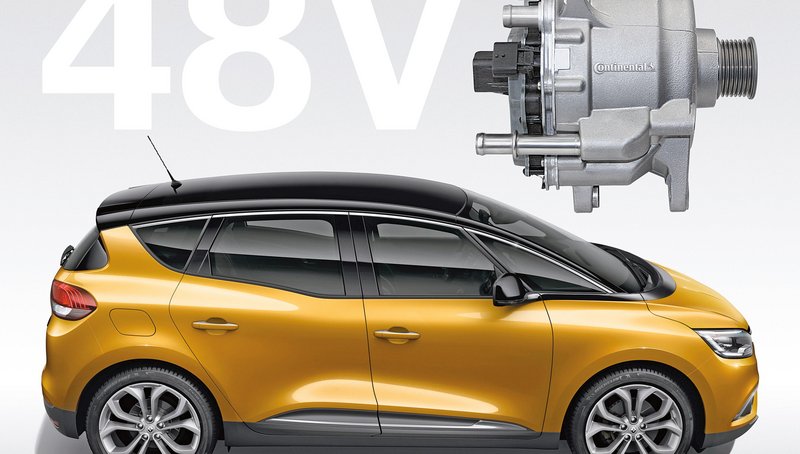Start of Production for 48-Volt Hybrid Modular System from Continental
- World's first 48-volt drive based on the Continental module to be used from end of 2016
- Water-cooled induction motor provides high-performance recovery and applies up to 150 newton meters to the crankshaft
- P0 architecture enables simple installation without fundamental changes to the vehicle and drive architecture
Regensburg, Nuremberg, Berlin. October 20, 2016. For years, the automotive industry has been talking about introducing mild hybrid systems based on 48-volt technology. Continental has now begun volume production of the first low-voltage hybrid drive, which will be introduced by French carmaker Renault (model: Renault Scenic Hybrid Assist) from the end of 2016. The first production solution combines an efficient, water-cooled induction motor with an integrated inverter. The electric motor transmits power via a belt drive directly to the crankshaft of the combustion engine – an arrangement referred to by experts as "P0 topology." Further production ramp-ups are soon to be set in motion on the basis of a modular system for 48-volt drives.
The 48-volt technology is regarded as a technology of the future, as the low voltage compared with conventional hybrid vehicles enables considerable savings in fuel consumption in return for moderate additional costs. Consequently, Continental anticipates that market penetration will be rapid, with four million vehicles with low-voltage hybrid drives to be produced worldwide in 2020. For 2030, the technology supplier's experts forecast a global market of as many as 25 million new vehicles. During development of the modular system, the engineers at Continental therefore placed great emphasis on achieving a high degree of efficiency for the overall system, simple adaptation to existing vehicle powertrain designs, and highly automated, cost-effective production.
The efficiency of a 48-volt system is largely dependent on the amount of drive and recovery output available in continuous operation. As a result, Continental has chosen to employ a water-cooled induction motor that can be connected directly to the engine's cooling circuit. This makes it possible to assemble a machine that, depending on the version, can continuously provide an output of six kilowatts and torque of 60 newton meters, all in the installation space of a conventional starter alternator. Using a belt drive means that up to 150 newton meters can be transmitted to the crankshaft. Within the modular system, only the length of the motor changes the power. The inverter, based on a metal-oxide-semiconductor field-effect transistor (MOSFET), is integrated in the housing lid, which saves space. The modular system from Continental also includes a DC/DC converter, which enables the 48-volt system to be connected to the vehicle's on-board power supply. This makes it possible to use some of the energy stored in the lithium-ion battery to stabilize the on-board power supply as well.
Simple adaptation to existing powertrain designs is a major benefit of the P0 concept that Continental has pursued. It enables the load point of the combustion engine to be shifted. The fuel savings demonstrated in test vehicles are considerable, with a figure of 13 percent in the New European Driving Cycle. In real-world use – especially in cities – the savings are even higher thanks to the greater share of driving spent in energy recuperation phases, and can reach up to 21 percent. This is helped by the fact that the combustion engine can be switched off when the vehicle approaches traffic lights, starting at speeds below 20 km/h. The combustion engine is always started with the 48-volt drive within just 0.2 seconds – a conventional starter needs roughly twice as much time. When the 48-volt drive is combined with a diesel engine as in its first production application, there is an additional effect. This is that the nitrogen oxide emissions produced during acceleration from low engine speeds fall by up to 10 percent, as some of the necessary torque is generated via the electric motor.
To enable cost-effective production at high volumes, Continental has developed new processes for manufacturing the electric motor. For example, the copper wire for the stator is not wound but comprises individual copper rods. Combined with innovative connection technology, this design enables not only highly automated production but also greater packing density, and thus more output from the same installation space.
Even after the start of production, Continental will continue to develop the 48-volt technology. As well as optimizing all components for the P0 arrangement, the focus will be on another system configuration, for with the P2 arrangement, the electric motor is located between the engine and the transmission. It can therefore be operated entirely independently of the combustion engine, which means that electric driving at speeds of temporarily up to 50 km/h is possible with a 48-volt drive as well. Such a solution, which enables fuel savings of up to 25 percent in concert with additional efficiency-boosting measures, was presented for the first time by Continental and Schaeffler at the 2016 Vienna Motor Symposium.

Simone Geldhäuser
Head of Media Relations, Spokesperson Finance, Business and Technology
Vitesco Technologies


